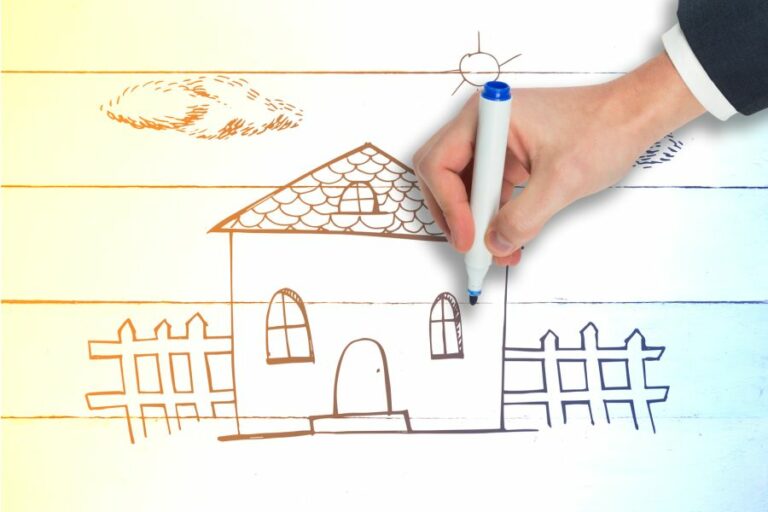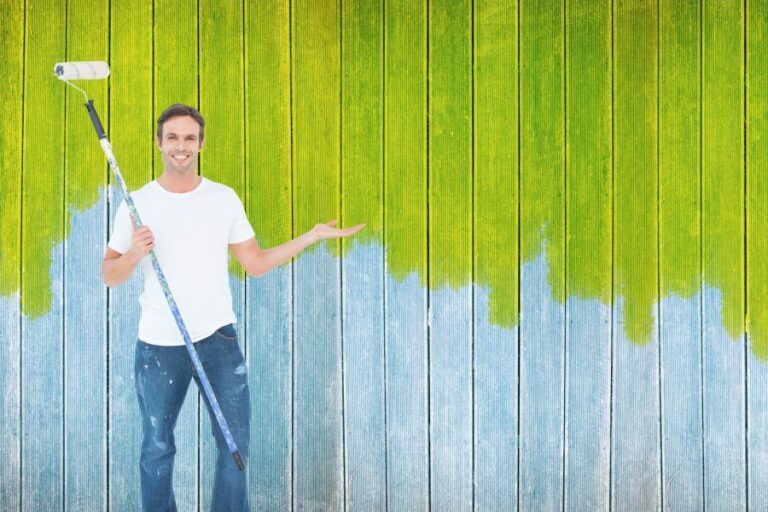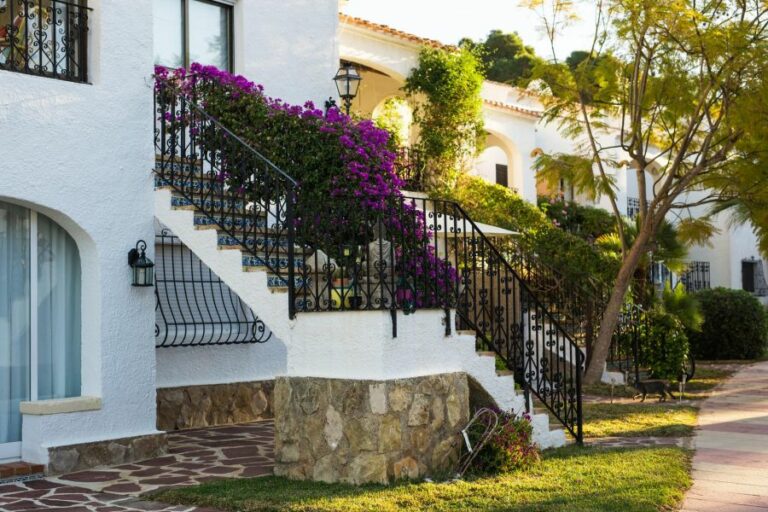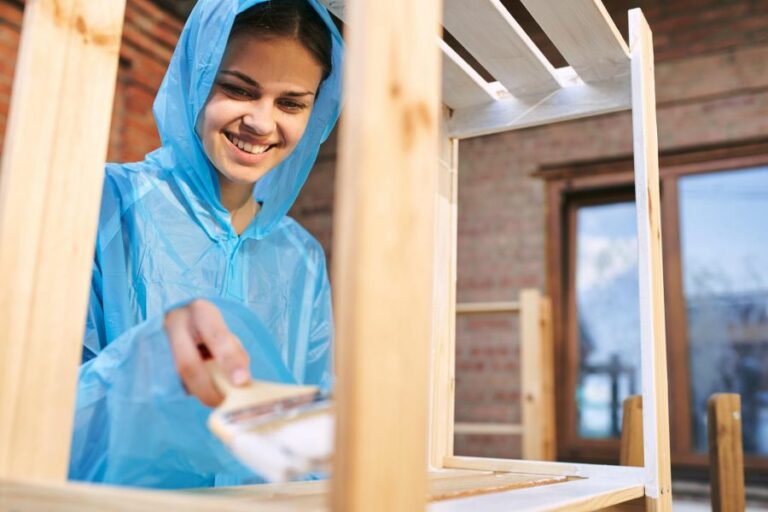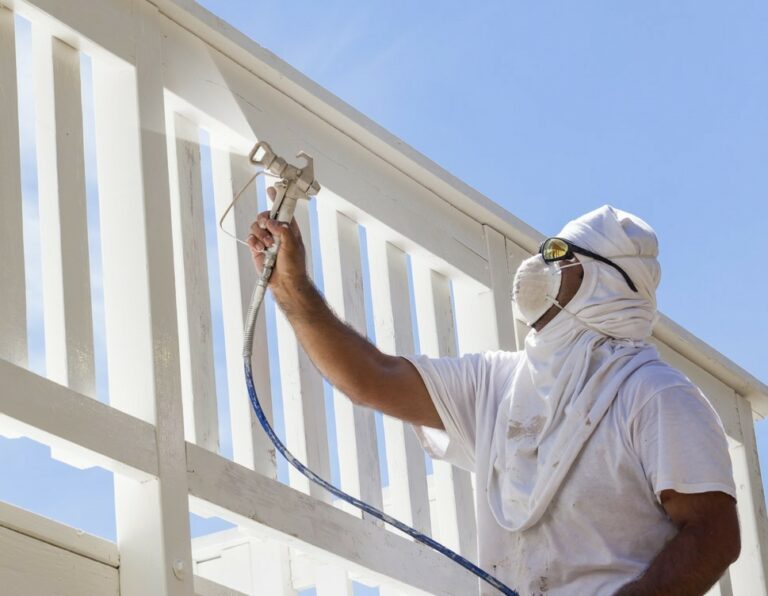How Much Does A Gallon Of Outdoor Paint Cover. What Pros Say
Discover the secret to achieving the perfect paint job for your home’s exterior. Let’s delve into the factors affecting how much area a gallon of paint can cover, the importance of primer, and recommended application techniques. Say goodbye to second-guessing and wasted paint as we provide you with the knowledge you need to make informed decisions for your next painting project.
How much does a gallon of outdoor paint cover:
Calculating paint coverage for outdoor projects requires understanding the influence of paint thickness, surface texture, and paint formulation. Generally, a gallon of outdoor paint covers 350-400 square feet, but various factors, like surface irregularities and paint type, can affect this estimation. Latex, oil-based, and acrylic paints have different coverage areas, while factors like primer and multiple coats for dark shades also play a role. A holistic understanding of all these aspects can help you plan your painting project effectively.

Discover the factors influencing coverage, including surface texture and color choice. Learn about the standard coverage rate for a gallon of paint and tips for optimal application. This guide will help you save time, money, and frustration while ensuring a stunning outdoor paint job.
Contents
- 1 Calculating Coverage: Gallons of Outdoor Paint Unraveled
- 2 Determine the Quantity of Paint Required for a 2000 Square Foot Home Exterior
- 3 What is the quantity of paint in gallons needed for a 1500 square feet exterior surface?
- 4 What is the required amount of paint in gallons for the exterior of a 1000-square-foot house?
- 5 Determination of Gallons of Paint Required for Painting a 3000 Sq Ft House Exterior
- 6 Determination of the Required Paint Quantity for Exterior Painting of a 2000 Square Foot House
Calculating Coverage: Gallons of Outdoor Paint Unraveled
Navigating the fascinating world of exterior paint concealments might leave one utterly bamboozled.
• The Intricacies of Paint Thickness and Terrains
The first constant one must comprehend is that the average paint thickness plays a pivotal role in ascertaining the overall coverage. Generally, a gallon of outdoor paint spans 350 to 400 square feet. Nevertheless, various factors contribute to the fluctuations in these estimations.
– Topography Variations: Smooth and Textured Surfaces
The bumps, niches, and grooves of an exterior wall quite decisively impact the paint’s spreadability. Immaculate and polished surfaces require less paint as there are no intricate textures to fill, making the adhesion process facile.
- Ravishingly smooth: Yielding the upper limit of 400 square feet, a standard one-gallon paint can conveniently blanket an unblemished and sleek surface.
- Intricately textured: With crevices to infiltrate and uneven protrusions to coat, the paint supply swiftly dwindles, restricting coverage to approximately 300 square feet or less per gallon.
– Decoding the Alchemy: Distinctive Formulations
Boundless variations in paint composition and viscosity produce variegated outcomes in coverage metrics. Delve into the constituents of the elixir to scrutinize its magic:
- Latex: Composed predominantly of water, pigments, and binding agents, latex paint enjoys widespread adulation for its durability, flexibility, and fast-drying aptitude. Given its supreme flow properties, a latex-based gallon begets 350 to 400 square feet of coverage.
- Oil-based: Revered for its lustrous sheen, this unctuous formulation relies on solvent and resin infusion. Boasting robust adhesiveness, oil-based paint may offer slightly less coverage, averaging between 300 and 350 square feet per gallon.
- Acrylic: Harnessing the virtues of synthetic resin, these emulsions exhibit optimal resistance to weathering woes. Championing hydrophobicity and UV stability, acrylic paint receives applause for a coverage range of 350 to 400 square feet per gallon.
• Mastering the Delicate Art of Layering: Opacity Chronicles
Venture into the enthralling realm of seamless coatings and envelope the edifice in exquisite tints, courtesy of multiple layers:
– Impeccable Priming: A Foundation for Virtuosity
Conjuring an unassailable barricade against the onslaught of moisture and peeling, priming lays a formidable groundwork for future pigmentation. Delight in captivating shades when a base coat is applied, as coverage can double with the assistance of primer.
– Darkest Hues: The Call for Additional Coats
Embrace an enigmatic visage by opting for satiny swarthy tones, cloaking the home in an aura of mystery. Somber shades demand multiple coatings to achieve an impeccable finish. Consequently, have additional paint gallons nearby when traversing the darker spectrum.
– Transparent Pursuits: Semi-Solid and Solid Stains
Eagerly dabble in a melange of pigmentations with the spectrum of translucent opacities, each boasting distinct coverage range:
- Semi-transparent: A delicate infusion of hues imbues the surface with subtle character, and a single gallon may envelop 250 to 350 square feet.
- Solid: Generating strikingly vibrant colors, opt for this formulation to enshroud any unsightly blemishes on the wall. This high-coverage panacea offers between 200 and 300 square feet per gallon.
• Grand Finale: Unveiling the Paint Conundrum
In the end, recognizing how much a gallon of outdoor paint covers necessitates a holistic understanding of paint constitution, surface intricacies, and desired finish. Devise a detailed blueprint, base estimations on the lower end of standard ranges, and equip yourself amply to realize your architectural masterpiece.
Type of Outdoor Paint | Coverage per Gallon (sq ft) |
|---|---|
Acrylic Latex Exterior | 350-400 |
Oil-Based Exterior | 300-350 |
Exterior Primer | 200-300 |
Exterior Stain | 150-250 |
Determine the Quantity of Paint Required for a 2000 Square Foot Home Exterior
A home’s exterior exudes character and charm, providing passersby with a glimpse into the lives within. A fresh coat of paint can often breathe new life into an abode’s facade, turning heads and leaving lasting impressions.
The proper estimation of paint required for a 2,000-square-foot dwelling is crucial, ensuring that the undertaking is both economical and efficient. In the discourse below, we shall furnish you with the necessary intel to accurately ascertain the volume of paint needed for your home exterior renovation.
• Delving into Surface Types and Paint Coverage
Different surface materials mandate distinct methods of approach when it comes to the actual painting process. Moreover, according to the surface’s innate attributes, it may render varying levels of absorption, affecting paint coverage.
Therefore, we must scrutinize the texture and material of the targeted exterior surfaces.
– Porous and Coarse Textures
Materials like stucco or concrete blocks often exhibit a rough, slightly porous texture. These surfaces require higher volumes of paint as the uneven relief and small crevices call for thicker coatings to ensure durability and an even finish.
Additionally, these materials might need a primer, further increasing paint usage.
– Smooth and Less Absorbent Textures
Surfaces such as wood siding, metal, and smooth masonry tend to have less absorbent properties. Consequently, a more modest amount of paint is necessary to evenly coat such materials, leading to lower overall paint consumption.
• Demystifying Paint Coverage Quotients
To accurately gauge the requisite quantity of paint, coverage details are indispensable. These figures typically engrained within the product’s specifications or label, illustrate the coverage per gallon, measured in square feet.
By dividing the targeted area (2,000 square feet) by the paint’s coverage quotient, one can determine the amount of paint demanded.
– A Word of Caution
Whilst it’s tempting to construe the coverage specifications at face value, paint quantities rarely adhere to these stipulated norms. Factors including surface texture, application methods, and painter experience can often mar the paint’s adherence to its theoretical coverage capacity.
Hence, it’s prudent to acquire extra paint for contingencies, ensuring mishaps don’t hinder your project’s progress.
• Customizing Paint Quantities to Surface Type and Coverage
By amalgamating and applying the surface-specific knowledge and paint coverage data garnered hitherto, an accurate assessment of paint quantity demands is imminent. Below, we expound upon the requisite adjustments tailored to specific surfaces and paint brands.
– Embark on the Path of Prudent Calculation
A conservative estimate, factoring in potential discrepancies and setbacks, is key to achieving desired outcomes without overextending resources. For instance, you may consider acquiring paint quantities that are 10-20% more significant than your initial estimate.
– Contemplate the Intricacies of Your Exterior Design
Architectural elements like trim, accents, and shutters can influence the overall paint requirement. Incorporate these unique factors into your calculations to avoid finding yourself in the unenviable position of a deficit mid-project.
• Reap the Rewards of Your Precise Estimation
Suppose you’ve been diligent and savvy in your calculations, taking into account variations across the surfaces and contingencies that may arise during the process. In that case, you’ll likely have procured a satisfactory amount of paint for your 2,000-square-foot exterior renovation.
Embrace the transformation that ensues as your house dons its new, eye-catching garment that mirrors the sterling taste and meticulous thought that went into the entire endeavor.
When the time comes to furnish your home with a revitalizing coat of paint, remember that attention to detail, from surface type to paint coverage, is essential.
By considering these factors and employing the tactics outlined above, you will have the necessary knowledge to embark on your paint estimating journey with confidence and poise.
What is the quantity of paint in gallons needed for a 1500 square feet exterior surface?
Painting your home’s exterior is an endeavor that necessitates careful planning and consideration. One crucial aspect of this undertaking is accurately ascertaining the quantity of paint required.
• Ascertain the Surface Material and Texture
Before diving into calculations, it is imperative to discern the material composition of your home’s outer walls. Various materials like brick, stucco, or siding possess diverse absorption rates, which will subsequently influence the quantity of paint needed.
– Brick and Stucco
In comparison to smoother surfaces, brick and stucco facades tend to exhibit a higher proclivity for paint absorption. Variegated textures and grooves in these materials can necessitate the application of a thicker paint layer.
A general approximation is that one gallon of paint will cover about 150-200 square feet of brick or stucco surface.
– Siding
When dealing with siding, whether wood, vinyl, or metal, the paint application requirements are dissimilar from those of brick or stucco. For wood siding, one gallon of paint will typically suffice for approximately 250 square feet.
Meanwhile, vinyl and metal siding exhibit less porosity, resulting in a coverage rate of about 300 square feet per gallon.
• Scrutinize Your Exterior’s Condition
An additional factor to ponder when calculating suitable paint quantities is the current state of your exterior surfaces.
– Aged or Weathered Surfaces
If the walls display significant wear or flaking paint, a higher volume of paint will be required to efficiently cover these imperfections. The exigency for multiple interspersed layers may augment the total quantity of paint needed.
– New or Pristine Surfaces
Surfaces that are relatively unblemished or recently primed necessitate smaller paint volumes. Their uniformity ensures an even distribution, thereby maximizing the coverage capacity of each paint gallon.
• Factor in a Second Coat or Contrasting Accents
Beyond the basic single-coat application, certain homeowners may opt for more elaborate paint schemes incorporating contrasting hues or accents. Be sure to include these supplementary layers in your paint calculations.
• Crux of Calculations
Taking into consideration surface material, texture, and condition, alongside your preferred paint scheme, you can now estimate the requisite number of gallons.
– Base Approximation
Begin with a base calculation: divide the total square footage (1500 sq ft) by the paint’s coverage rate. Remember that coverage rates vary between 150-300 square feet per gallon, depending on the material and texture.
– Adjustment for Factors
With your initial estimate, it is time to finetune the number based on supplementary factors, such as surface condition, accents, or multiple coats. Multiply the base calculation by the appropriate factor(s). For instance, doubling the number for a second coat or increasing by 25% for surfaces in poor condition.
– Final Calculation
Once all calculations have been executed, it is prudent to incorporate a small buffer, typically 10%, to account for potential miscues or contingencies. This will ensure you acquire enough paint for your project without wasting excess.
• Example Scenario
Suppose you have a 1500 square foot stucco exterior in moderate condition and plan to apply two coats of paint with textural coverage averaging 175 square feet per gallon.
- Base Calculation: 1500 sq ft / 175 sq ft per gallon = ~8.6 gallons
- Adjustment for Factors: 8.6 gallons 2 (second coat) = 17.2 gallons
- Final Calculation: 17.2 gallons + 10% buffer = ~19 gallons
In this scenario, purchasing nineteen gallons of paint would be a judicious and efficacious decision.
In conclusion, when endeavoring to paint your 1500-square-foot exterior, taking stock of factors such as material, texture, current condition, and your desired paint scheme will ensure a successful, visually engaging outcome. By conscientiously performing these calculations, you can remain confident that your home will radiate charm and allure for years to come.
What is the required amount of paint in gallons for the exterior of a 1000-square-foot house?
Embarking on an exterior painting journey often leads to a crossroads where individuals ponder the quantity of paint necessary.
• Initiating the Expedition: Identifying Factors
– Surface Type and Texture
Paint adheres differently, depending on a plethora of factors, some of which include substrate composition, whether it’s brick, stucco, or siding, and the roughness or smoothness of the surface. Therefore, these elements influence the number of coats required for satisfactory coverage.
– Color Selection
Opting for a light hue or a dazzlingly vivid one can affect the amount of paint needed for comprehensive coverage. Transitioning from a muted tone to a livelier shade or vice versa can prompt additional coats for optimal results.
– Efficiency and Thickness
Various paints possess disparate consistencies, which impact the application. Some boast a robust coverage and necessitate lesser coats, while others may mandate multiple layers to achieve a desirable appearance.
• The Calculation Conundrum: Unraveling the Numbers
– Step 1: Estimating Surface Area
To determine the amount of paint required for a 1000-square-foot house, one must first measure the total exterior surface area. This calculation should factor in windows, doors, trim, and other unique features. To ascertain the square footage, multiply the height by the width of each section.
– Step 2: Divulging Paint Coverage
Generally, a gallon of paint covers approximately 350 square feet. However, this figure may vary based on the specific brand and paint type. Consult the paint can’s label for the manufacturer’s recommended coverage per gallon.
– Step 3: Partitioning the Coverage Equation
Divide the total exterior square footage by the number of square feet of one gallon of paint covers. This result will indicate the quantity of paint necessary for a single coat. For instance: 1000 sq ft 350 sq ft per gallon = 2.86 gallons
– Step 4: Considering Multiple Coats
A precise conjecture stipulates the necessity for two coats. Multi-layering not only enhances aesthetics but also bolsters longevity. Hence, multiply the number of single-coat paint gallons by the projected number of layers. Continuing with our example, 2.86 gallons 2 coats = 5.72 gallons.
Note: Surface type and color selection may engender the need for supplementary paint, as previously expounded.
• Expert Insights: Tips for Prudent Paint Procurement
– A Libation for Error: Overestimation
Contemplate procuring slightly more paint than the calculations indicate, as this approach provides leeway for touch-ups and minor discrepancies in measurements.
– The Blending Battle: Batch Consistency
Purchasing an abundant supply of paint mitigates the likelihood of encountering a variance in color tones. To consolidate uniformity across the entire structure, ensure that all cans originate from the same production batch.
– Ecological Endeavors: Proper Disposal
Initiate environmentally conscious disposal efforts with leftover paint. Numerous recycling centers and charities tender responsible disposition alternatives. Avoid disposal in regular trash or pouring leftover paint down the drain.
• Conclusion: Setting Sail for a Successful Painting Project
By diligently adhering to this step-by-step formula for ascertaining paint needs, homeowners can embark on a successful painting project. Factor in surface type and texture, color selection, and thickness, perform necessary calculations and heed expert advice for procurement.
Fabricating a polished, 1000 square foot house exterior awaits with the application of this comprehensive guideline.
Determination of Gallons of Paint Required for Painting a 3000 Sq Ft House Exterior
Embarking on an exterior painting project? Ensuring the appropriate volume of paint for a 3000 sq ft house may appear convoluted, but our thorough guide, replete with meticulous details and precise calculations, will help you decipher the arcane science of paint estimation.
• Paint Coverage Varies: Factors to Assess
– Surface Absorbency
Different surfaces exhibit unique absorbency traits. For instance, porous materials like stucco and raw wood require more paint, whereas smoother textures like vinyl or aluminum siding demand a lesser amount. Moreover, diverse colors and finishes influence paint coverage.
Consider the Primer
A judicious utilization of primers imparts a harmonious adhesion and consistent finish. Ill-matched surfaces or significant color changes warrant the use of primers, increasing the final paint tally.
– Measure and Tabulate the Surface Area
For an impeccable calculation, measure each surface on your house’s exterior walls, trims, shutters, doors, and windows. Tally the area separately to obtain the cumulative square feet, also incorporating the minutest corner or recess.
• Delve into the Paint Formula
– Know Your Paint Coverage Ratio
Varying paint brands possess disparate paint coverage ratios. A cursory examination of the paint can label unveils vital intel about the product’s coverage per gallon. Ponder these details meticulously before selecting the optimal brand for your project.
– The Rule of Two
A seamless and fastidious paint job often necessitates a double coat for the utmost finish. Apprise yourself of this likelihood of evading paint insufficiency midway through your endeavor.
• Embarking on the Calculations: A Didactic Example
Let’s formulate the gallons required for a 3000 sq ft house bereft of architectural complexities.
– Surface Area Tally
Suppose the wall area measures 2800 sq ft, accounting for fenestrations. The trims, shutters, doors, and windows amount to 200 sq ft, which will be dealt with using a distinct formula.
– Paint Coverage Ratio Selection
Decide on paint with a coverage ratio of 350 sq ft per gallon.
– Prime the Surface
Let us assume the primer’s coverage ratio is 200 sq ft per gallon, anticipating one primer coat.
Walls
To coat the 2800 sq ft walls:
- Primer: 2800 200 (coverage) = 14 gallons
- Topcoat: 2800 350 (coverage) 2 coats = 16 gallons
Aggregating the result: 14 + 16 = 30 gallons
Trims, Shutters, Doors, and Windows
Intending one primer coat and one topcoat for these additional surfaces:
- Primer: 200 200 (coverage) = 1 gallon
- Topcoat: 200 350 (coverage) = 0.57 gallons
Summing the result: 1 + 0.57 1.6 gallons (round up to 2 gallons)
– The Final Tally
For our simplified example of a 3000 sq ft house exterior, the requisite paint volume equates to 30 gallons for walls and 2 gallons for additional surfaces, culminating in a 32-gallon requirement. Alas, in real-life scenarios, myriad factors mandate a gradation of estimations and contingencies.
• Synthesis: Fathom Paint Estimations Effortlessly
To overcome the labyrinth of paint estimation for your 3000 sq ft house exterior, hearken to these fundamental precepts: account for surface type, measure meticulously, comprehend your paint’s coverage ratio, and allow for contingencies.
By strictly adhering to these guidelines, you unveil the abstruse art of estimating the gallons of paint required, safeguarding a spectacular finish for your home.
Determination of the Required Paint Quantity for Exterior Painting of a 2000 Square Foot House
Painting the exterior of a house can rejuvenate its appearance and transform it from mundane to mesmerizing.
Before commencing this endeavor, it is crucial to assess the required quantity of paint. For a 2000-square-foot residence, various factors must be considered, such as the type of paint, surface conditions, and architectural intricacies.
With precision and judicious calculations, the perfect quantities of paint can be deduced.
• The Math behind Paint Coverage
To commence, understanding the coverage capacity of paint is pivotal. Typically, a gallon of paint covers approximately 350 square feet with a single coat. Bearing in mind that most exterior painting projects necessitate two coats, the basic formula to deduce paint quantities is delineated below:
(Number of square feet / Coverage per gallon) * Number of coats = Total gallons required
For a 2000 square foot exterior, employing this formula results in the following calculation:
(2000 / 350) * 2 = 11.43 gallons
Thus, roughly 11.43 gallons of paint would be required to cover a 2000-square-foot house with two coats. However, nuance and intricacies must be examined further to ensure accuracy in the final estimate.
• Surface Conditions and Paint Absorption
The surface conditions of the house play a pivotal role in paint absorption. Porous surfaces, such as stucco or rough wood, consume more paint than smooth surfaces like vinyl or metal siding.
Factoring in the surface type, it may be prudent to increase the paint estimate by 10% – 20%, depending on the level of paint absorption.
For example, if the majority of the exterior consists of porous surfaces:
11.43 gallons * 1.2 (an extra 20%) = 13.72 gallons
In this scenario, an estimated 13.72 gallons of paint would be required.
• Architectural Intricacies and Variation
No two houses are identical; each contains unique architectural features and surface variations. Windows, doors, and trim work must be examined carefully to finalize the paint estimate.
Generally, these elements reduce the overall paintable surface area, which may lead to a decreased requirement for paint. Subtracting the square footage of windows and doors from the total square footage provides a refined estimate.
For instance, suppose the combined square footage of windows and doors equates to 200 square feet. Deducting this from the overall area results in the following:
2000 square feet – 200 square feet = 1800 square feet
Subsequently, input this revised square footage into the prior formula:
(1800 / 350) * 2 = 10.29 gallons
Here, a more accurate estimate advocates for 10.29 gallons of paint.
• A Final Word of Wisdom
When embarking on an exterior painting project, meticulous calculations and contingency planning ensure success. By laboriously factoring in paint coverage, surface conditions, and architectural nuances, a comprehensive and exhaustive estimate can be produced.
Furthermore, procuring additional paint, approximately 10% more, is prudent in case of unforeseen challenges and can circumvent potential paint shortages during the project.
By adhering to these guidelines, your 2000 square foot house will soon be enveloped in a vivid cloak of color, exuding charm and inviting admiration from all who pass by.

